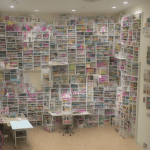Crafting hobbies have a way of exploding, don’t they? You began with one little sewing kit, and before you knew it, your home was overflowing with paints, brushes, scrapbooking supplies, and an array of fabrics. Fear not, your creative chaos can be tamed. A dedicated craft room with an efficient layout is your salvation. You’ll soon find that a well-designed space will enhance your creativity, keep you organized, and make your crafting more enjoyable.
Designing Your Craft Room Layout
When it comes to designing your craft room, the first step is to determine what activities you’ll be doing in the space. Will you be sewing, painting, or scrapbooking? Once you have that figured out, you can start to create a layout that will work best for these activities.
Have you seen this : How to Design a Home Library with a Hidden Door for a Secret Retreat?
Firstly, consider your workflow. For instance, if you’re into sewing, you’ll want your sewing machine, cutting station, and ironing board arranged in a sequence that allows for easy movement between these stations.
Next, think about what kind of storage you’ll need. Shelves are a great way to keep your supplies organized and within easy reach. Wall-mounted shelves save valuable floor space, while freestanding shelves provide more versatility.
Topic to read : What Are the Innovative Container Gardening Ideas for Small Patios or Balconies?
Finally, remember to factor in good lighting. Bright, natural light is ideal for most crafting activities. Consider positioning your workspaces near windows, or invest in high-quality task lighting.
Storage Solutions for Your Craft Room
A craft room can quickly become chaotic without adequate storage. To keep your space organized, it’s essential to have a place for everything. Start by taking stock of all your supplies. Knowing what you have and how much storage space you’ll need is key to avoid clutter.
Shelves, as previously mentioned, are an excellent solution for storage. They can be used for storing fabric, yarn, paint, brushes, and other crafting supplies. You could also use pegboards on the wall for hanging tools and supplies that you use often.
Consider using clear storage boxes for smaller items. These allow you to see what’s inside, so you don’t have to rummage around to find what you need.
If you’re a scrapbooker, consider a paper organizer or a filing cabinet to keep your papers sorted and crease-free. For sewing enthusiasts, thread racks, and fabric organizers can keep your materials tidy and at hand.
Ideas for Separating Your Craft Room into Zones
To achieve an efficient layout, consider dividing your room into zones based on the different activities you’ll be doing. An office zone for paperwork, a sewing zone, a painting zone, and a scrapbooking zone, for instance.
One idea is to use furniture to divide the space. A shelving unit can act as a divider between the sewing and painting zones, for example.
Alternatively, you may choose to use rugs or floor mats to visually separate your areas. This will not only delineate your zones but also protect your flooring from any potential craft-related mishaps.
Another idea is to utilize wall space to designate different zones. A chalkboard wall or corkboard wall can serve as a visual boundary while providing a functional workspace.
Lighting in Your Craft Room
Lighting is a crucial aspect of your craft room design. Good lighting will not only make your projects easier to see and therefore better in quality, but it can also reduce eye strain and fatigue.
Consider using a mix of ambient, task, and accent lighting. Ambient lighting, such as overhead lights, provides general illumination. Task lighting, like desk lamps, offers focused light where you need it most. Accent lighting, such as under-cabinet lights or spotlights, can highlight your display areas or add a touch of mood lighting.
Don’t forget about natural light. If you can, position your main work areas near windows. The quality of natural light is hard to beat, and it will make your craft room a more pleasant space to work in.
Personalizing Your Craft Room
Finally, don’t forget to personalize your craft room. It should reflect your style and inspire creativity. Consider incorporating your favorite colors into the decor.
Hang artwork or inspirational quotes on the wall. If you’re into scrapbooking, why not display some of your favorite scrapbook pages in frames? For those who love sewing, a wall of fabric swatches can serve as both decoration and inspiration.
Remember, your craft room is your space. It should be a place where you feel motivated and inspired. The right design will make your crafting activities more enjoyable and productive. So, dust off those sewing machines, shake up those paint bottles, and start planning the craft room of your dreams.
Making the Most of Your Craft Space
With any room, but especially with a craft room, optimizing the space is crucial. You need to take into account all the activities you plan to do, the materials you plan to use, and the storage solutions you need. All of this while also ensuring that you have enough space to move around comfortably.
Firstly, consider the size and shape of your room. If you have a small craft room, you might need to get creative with your use of space. Vertical storage solutions such as wall-mounted shelves or pegboards can help you make the most of your wall space. If you have a larger craft area, you might want to consider using room dividers or furniture to create separate zones for each activity.
Secondly, think about your workflow. If you’re into sewing, for example, you might want to have a separate area for cutting fabric, an area for your sewing machine, and another area for ironing. By setting up your room in a way that allows for easy movement between these different areas, you can make your crafting process more efficient and enjoyable.
Thirdly, consider the type of furniture you need. A comfortable chair and a sturdy table are essential. You might also want to add a drafting table for drawing or painting, or a lightbox for tracing designs. Remember, comfort is key. If you’re not comfortable in your craft room, you won’t enjoy spending time there.
Finally, don’t forget about your craft supplies. Organizing your craft supplies can be a daunting task, but it’s a crucial step in setting up your craft room. Use clear storage boxes to keep your supplies organized and easy to find. Add labels to each box so you know what’s inside at a glance. And remember, keeping your supplies organized isn’t a one-time task. You’ll need to keep up with it regularly to maintain your craft room’s efficiency.
Conclusion: Crafting Your Perfect Room
In conclusion, setting up an efficient and comfortable craft room doesn’t have to be a daunting task. With careful planning and organization, you can create a space that not only meets your crafting needs but also inspires your creativity.
Consider the activities you plan to do, the supplies you need to store, and the furniture you need. Plan your layout carefully and make the most of your space. Use clever storage solutions to keep your supplies organized and easy to find. And most importantly, personalize your craft room to reflect your style and taste.
Creating the perfect craft room might take some time and effort, but the reward will be a space where you can indulge in your crafting hobbies with joy and ease. So get started on planning your dream craft room today, and prepare to enjoy countless hours of crafting bliss. Your paintbrushes, scissors, and scrapbooking materials await your touch in your newly organized, personalized, and efficient craft room.













